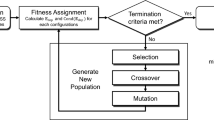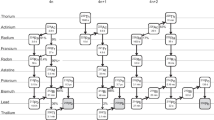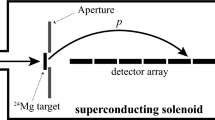Abstract
In accelerator production of radionuclides, thin-target yield yEOIB(E) vs. projectile energy, at the end of an instantaneous bombardment (EOIB), is the slope at the “origin” of the growth curve of the activity of a radionuclide per unit beam current vs. irradiation time, for a target in which the energy loss is negligible in respect to projectile energy. Conversely, thick-target yield Y(E,ΔE) is a function of particle energy E (MeV) onto the target and energy loss ΔE (MeV) into target itself, obtained experimentally or by integration of thin-target excitation function y(E). Some local maxima on Y(E,ΔE) curves are present in many cases. As a relevant conclusion, use of target thickness larger than the “effective” value is unsuitable, due to larger specific power deposited by the beam in target material, instead of cooling system. Moreover, increasing amount of target material leads to a lower value of specific activity, due to larger amounts and volumes of chemicals and equipment. Y(E,ΔE) curves and their maxima permit calculating optimal irradiation conditions to produce radionuclides with maximum yield, specific activity and radionuclidic purity. In order to join the advantages of accurate knowledge of thin-target excitation functions, very selective radiochemical separations were optimised, without intentional addition of an isotopic carrier.
Similar content being viewed by others
References
Sabbioni E., Goetz L., Birattari C. and Bonardi M.: Sci. Total Env. 17 (1981) 257.
Sabbioni E. et al.: J. Radional. Nucl. Chem., 160 (1992) 549.
Gallorini M., Bonardi M., Groppi F. and Saponaro S.: J. Radioanal. Nucl. Chem. 193 (1995) 39.
Bonardi M., Gallorini M., Groppi F. and Saponaro S.: Microchem. J. 51 (1995) 278.
Bonardi M. et al.: J. Radioanal. Nucl. Chem. 236 (1998) 159.
Groppi F., Bonardi M., Birattari C., Gallorini M. and Gini L.: J. Radioanal. Nucl. Chem. 249 (2001) 289.
Wolf A.P., Tewson, T.J. and Welch M.J.: J. Nucl. Med. 22 (1981) 392.
Fowler J.S. and Wolf A.P.: The synthesis of carbon-11, fluorine-18, and nitrogen-13 labelled radiotracers for biomedical applications, Technical Information Center, US DOE, Springfield, Virginia, USA, NAS-NS-3201, September 1982, p. 28.
Friedlander G., Kennedy J.K., Macias E.S. and Miller J.M.: Nuclear and Radiochemistry, 3rd Ed., John Wiley and Sons, New York, USA, 1981.
Lieser K.H.: Nuclear and Radiochemistry. Fundamentals and Applications. Revised Ed., Wiley and Verlag, VHC, Berlin, Germany, 2001.
Mills I., Cvitas T., Loman K., Kallay N. and Kuchitsu K. (Eds.) Quantities, Units and Symbols in Physical Chemistry, 2-nd Ed., Blackwell Scientific Publications, Oxford, UK, 1993, pp. 7, 42
Inczedy J., Lengyel T., Ure A. M., Gelencser A. and Hulanicki A. (Eds.): Radioanalytical Methods, In: IUPAC Compendium of Analytical Nomenclature, definitive rules 1997, 3-rd Ed., UK, 2000. Chapter 16.
Firestone R.B., Baglin C.M. and Chu F.S.Y.: Table of Isotopes, 8-th Ed., 1998, Update on CD-ROM, John Wiley and Sons, New York, USA, 1998.
McNaught A.D. and Wilkinson A. (Eds.): IUPAC Compendium of Chemical Terminology, Golden Book, 2-nd Ed., Blackwell Science, Oxford, UK, 1997.
Ruzicka J. and Stary J.: Substoichiometry in Radiochemical Analysis, Int. Series of Monographs in Analytical Chemistry, Vol. 30, Pergamon Press, Oxford, UK, 1968.
Toelgyessy J., Braun T. and Kyrs M.: Isotope Dilution Analysis, Pergamon Press, Oxford, UK, 1972.
Toelgyessy J. and Klehr E.H.: Nuclear Environmental Chemical Analysis, Ellis Horwood Limited, Chichester, UK, 1987.
Panico R., Powell W.H. and Richer J.C. (Eds.): A Guide to IUPAC Nomenclature of Organic Compounds, Recommendations 1993, Blackwell Scientific Publications, Oxford, UK, 1994.
McCleverthy J.A. and Connelly N.G. (Eds.): Isotopically Modified Inorganic Compounds, In: IUPAC Nomenclature of Inorganic Chemistry II, Recommendations 2000, RSC, UK, 2001, p. 23.
Nesmeyanov A.N.: Radiochemistry, MIR Publishers, English translation, Moscow, Russia, 1974, pp. 49, 167.
Bonardi M. and Groppi F.: Report INFN/TC-01/04, SIS-Pubblicazioni, Frascati, Roma, 2001, Italy.
Bonardi M.L. and Groppi F.: Microchem. J. 73 (2002) 153.
Leigh G.J. (Ed.): IUPAC Nomenclature of Inorganic Chemistry, Recommendations 1990, Blackwell Scientific Publisher, Oxford, UK, 1990.
Birattari C., Groppi F. and Sabbioni E.: Report INFN/TC-01/22, SIS Pubblicazioni, Frascati, Roma, Italy, 2001.
Bonardi M., Birattari C., Groppi F. and Sabbioni E., Appl. Radiat. Isot., 57/5 (2002) 617–635.
Bonardi M. et al.: J. Radioanal. Nucl. Chem. 195 (1995) 227.
Bonardi M., Groppi F., Birattari C., Arginelli D.: J. Analyt. Environ. Chem. 92 (2002) 795.
Bonardi M. et al.: J. Radioanal. Nucl. Chem. 236 (1998) 159.
Gallorini M., Rizzio E., Birattari C., Bonardi M. and Groppi F.: Biol. Trace El. Res., 71–72 (1999) 209.
Bonardi, M.: In: IAEA Consultant's Meeting on “Nuclear Data Requirements for Medical Radioisotope Production”, Tokyo, April 1987, IAEA Document, INDC(NDS)-195/GZ, IAEA, Vienna, Jan 1988, p. 98.
IAEA-TECDOC-1211, IAEA, Vienna, Austria, May 2001.
Basile D. et al.: Int. J. Appl. Rad. Isot. 32 (1981) 403.
Bonardi M. and Birattari C.: J. Radioanal. Chem. 76 (1983) 311.
Smith D.L.: Probability, Statistics, and Data Uncertainties in Nuclear Science and Technology. OECD/NEA, ANS, Illinois, USA, 1991.
Kleinbaum D.G. and Kupper L.L.: Applied Regression Analysis and Other Multivariable Methods, Duxbury Press, Boston, Massachusetts, USA, 1986.
Ziegler F.: SRIM 2000 code, IBM-Research, Yorktown, New York, USA, 2000.
Abbas K. et al.: J. Labelled Cpd. Radiopharm. 44 (2001) S802.
Bonardi M. et al.: European J. Nucl. Med. 28 (2001) PS_727.
Groppi F., Birattari C., Bonardi M. and Gini L.: Microchem. J. 73 (2002) 203.
Author information
Authors and Affiliations
Additional information
Acknowledgement: This paper is dedicated to Alfred P. Wolf (1999†) of Brookhaven National Laboratory, BNL, Upton, New York, USA, who clarified the concept and terminology concerning specific activity of radionuclides and labelled compounds.
Rights and permissions
About this article
Cite this article
Bonardi, M.L., Groppi, F., Birattari, C. et al. Thin-target excitation functions: a powerful tool for optimising yield, specific activity and radionuclidic purity of accelerator-produced radionuclides. Czech J Phys 53 (Suppl 1), A393–A403 (2003). https://doi.org/10.1007/s10582-003-0051-6
Issue Date:
DOI: https://doi.org/10.1007/s10582-003-0051-6




